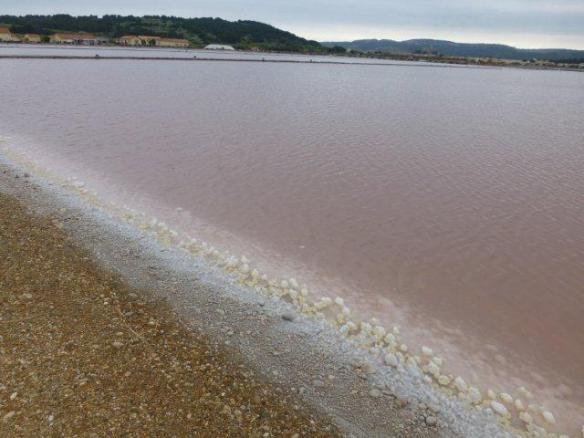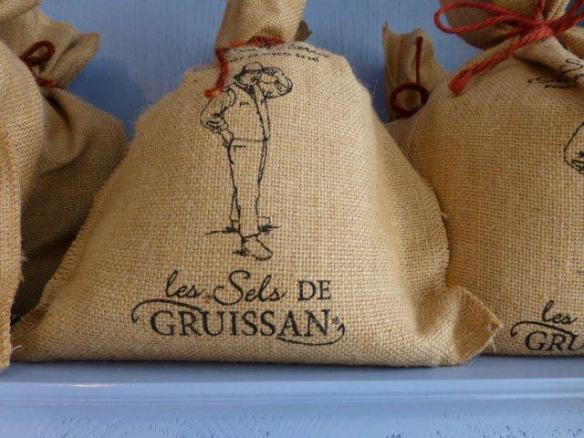There’s salt and then there’s sea salt – one of the many things I learnt on a recent visit to the Salin de l’Ile Saint-Martin in Gruissan. The salin is located west of the old town, on a site that stretches over 360 hectares – add four zeros to that and you get 3.6 million square meters, and that’s over five hundred football fields!! And if you think that’s large, the salin in Gruissan is the smallest on the mediterranean coast! The largest one is at Salin de Giraud, and is over ten times the size.
Our guide welcomed us to the Salin de l’Ile Saint-Martin and asked us to switch our mobile phones to silent – a good start I thought, shows that this lady is serious! Our visit began with some vocabulary. A salin is the place where sea salt is produced by evaporation in the south of France. A marais salant also produces sea salt but along the French Atlantic coast. A saline is a salt mine where rock salt is produced. That out of the way we moved on to another term: a saunier is the man responsible for a salin and to become worthy of the name, you have to have at least 10 years of experience. The saunier usually works on his own for most of year, with extra staff drafted in only during the harvest in August.
The saunier’s work starts in February, when he starts to pump sea water into the largest basin, the salin being above sea level. The water is captured 170 metres from the shore, to avoid any pollution. After a few days in the first basin, the water commences its long journey through a further 99 basins. To start with, the sea-water contains 26g of sodium chloride per litre (NaCl), along with several other salts (magnesium, calcium, sulfur and potassium). The saunier’s job is to ensure that the end product is pure sodium chloride and he achieves that by progressive evaporation, moving the water from one basin to another, on the way covering 100km. When the water reaches the last basin, the concentration of sodium chloride has reached 260g per litre, and some of the other salts will have crystallised out along the way. At that point the saunier lets the brine flow into the crystallisation basins, the last stop on the way to becoming sea salt. This is where the magic happens – as more water evaporates the sodium chloride starts to crystallise on the bottom of the basins, forming a layer of sea salt crystals, which can be up to 15cm thick in a good year. The crystallisation basins have a beautiful purple pink hue to them – we had to wait right until the end of our visit for our guide to explain the reason: of all life forms only one species of algae can survive in what is deemed a sterile liquid. The colour comes from beta carotene contained in the algae and as soon as the salt is harvested it starts to disintegrate and disappears.
At various times during the season the saunier harvests what is called fleur de sel. This is a very fine salt, which crystallizes spontaneously on the surface of the brine in the crystallisation basin. It has to be skimmed carefully whenever it appears as it will sink to the bottom during the day. The resulting salt flakes are of course more expensive than regular sea salt.
The harvest of the sea salt takes place in August. When the saunier decides the moment has come he will drain one crystallisation basin at a time, the water draining away any other salts still in suspension, leaving behind the pure sodium chloride. Harvesting can be performed two ways: either by hand with flat shovels, or by machine – the end result is the same, a big mountain of sea salt, which is then processed further.
Before the end of our walk our guide told us to put our hands into one of the crystallisation basins and to take out some salt crystals. It looked as though that would be very easy – just scoop some out – but to my surprise it was more or less impossible to dislodge anything! Luckily one of the members of our small group had his trusted pocket knife and prised out a few lumps! In the brine the sodium chloride crystals are translucent; it is only on contact with the air that they become opaque and white.
Our guide advised that we should have two kinds of salt for cooking – regular coarse sea salt (gros sel), which is added during the cooking process, to allow the water to dissolve the strong bond between the Na and Cl ions, and fleur de sel, which is sprinkled over food at the end of cooking (think of a grilled steak :-)) or used in salads, because the bond between Na and Cl is not as strong and dissolves more readily. Finely milled sea salt still has a very strong bond between the ions and will not dissolve readily, so she thought it was a waste of time to use that at the table. Another useful piece of advice was to check the labelling on any packet of salt. A lot of table salt has fillers, which can be anticoagulant agents, and other salts, which do not have a salty taste (only sodium chloride tastes of salt!). With pure sea salt you are getting what you’re buying, and the coarse salt is not very expensive.
On our way back to the starting point, we were asked to think of uses for sea salt. All of us came up with gritting and use in food, but nobody had any idea that there are around 14,000 uses for sodium chloride!! Staggering for sure. It is used in a wide variety of chemical processes (no PVC without it), in the cosmetic industry, food preservation etc, etc.
Life on this planet would not be possible without salt, as all animal life requires sodium chloride for the cells to function. Next time you use sea salt, take a moment to think of all the work that’s gone into it.
On the way out (or on the way in) you’ll see a few other buildings, which have been converted to new uses. One houses the salt museum and shop, where you can buy the locally produced sea salt and fleur de sel along with a number of other local products (wine and cookies/sweets). Closest to the salin is the restaurant, where you can eat fish baked in salt crust, along with locally produced oysters and other delicious food. Oysters are also available to be taken away. The last building open to the public contains an art gallery, which houses regularly changing exhibitions of work by local artists.
For more information visit the website of the Salin de l’Ile Saint-Martin. To rent a holiday villa with a view of the salin visit www.midihideaways.com/clos


























i love this post. so interesting and the pictures are great. i grew up in a little town near Syracuse NY and there was a salt mine there. my mother took us every now and then. my favorite salt is Murray River salt from Australia though I love tasting salts and have a quite a few. thanks for the tour!
LikeLike
Hi Denise and Sandy, thanks so much for message – glad you enjoyed this one!! You’d have a great time in the shop at the salin, I think they have ten different flavoured salts, a lot of which smell divine! I even spotted bath salts, but they were well away from the table salt 🙂
LikeLike
I enjoyed reading about salt! I was in Bonaire earlier this year and took some pix of the salt pans, http://vsperry.wordpress.com/2013/03/20/salt-flats/ but there was no guide to tell me what I was seeing…very cool!
LikeLike
Hi Virginia, thank you for stopping by and very glad to know you enjoyed the post! I like the pictures in your salt post!!
LikeLike
Who knew there was so much to know about salt? Now I understand why ‘fleur de sel’ is precious! Thanks for the informative post.
LikeLike
Hi Mel,
thank you, glad you enjoyed the read!! There was a lot of other info I wanted to add, but I’m always weary of making the posts overly long…
LikeLike
This is my first time visiting your site, and I can say I will be spending a lot more time here, after scrolling down to see your incredible photos of so many things that interest me: processions, pigs, truffles, food, flowers. … I’ve not visited this part of France, yet! Your photographs are stunning and there’s so much to learn about. Thank you.
LikeLike
Hi Jackie,
thansk so much for your kind comments – I’m very happy to hear that you are enjoying my blog!
LikeLike
This is so cool! 🙂
LikeLike
Really enjoyed that. We visited somewhere like this a few years ago, and I loved it. I didn’t know about the difference between the coarse sea salt and fleurs de sel though – very interesting. On another holiday we went down the salt mines in southern Poland – that was also a fascinating experience, though the clanking lifts (in darkness!) were a bit alarming!
LikeLike
Hi Hedwiga, glad you enjoyed the read and interesting to hear about the salt mines in Poland – sounds like a fun thing to do!
LikeLike
Pingback: Food, glorious food | midihideaways